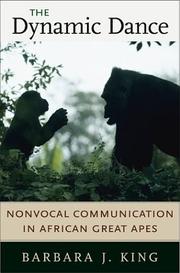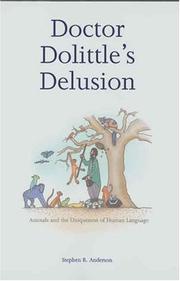| Listing 1 - 4 of 4 |
Sort by
|

ISBN: 0674039610 9780674039612 9780674015159 0674015150 Year: 2004 Publisher: Cambridge, Mass. : Harvard University Press,
Abstract | Keywords | Export | Availability | Bookmark
 Loading...
Loading...Choose an application
- Reference Manager
- EndNote
- RefWorks (Direct export to RefWorks)
Mother and infant negotiate over food; two high-status males jockey for power; female kin band together to get their way. It happens among humans and it happens among our closest living relatives in the animal kingdom, the great apes of Africa. In this eye-opening book, we see precisely how such events unfold in chimpanzees, bonobos, and gorillas: through a spontaneous, mutually choreographed dance of actions, gestures, and vocalizations in which social partners create meaning and come to understand each other. Using dynamic systems theory, an approach employed to study human communication, Barbara King is able to demonstrate the genuine complexity of apes' social communication, and the extent to which their interactions generate meaning. As King describes, apes create meaning primarily through their body movements--and go well beyond conveying messages about food, mating, or predators. Readers come to know the captive apes she has observed, and others across Africa as well, and to understand "the process of creating social meaning." This new perspective not only acquaints us with our closest living relatives, but informs us about a possible pathway for the evolution of language in our own species. King's theory challenges the popular idea that human language is instinctive, with rules and abilities hardwired into our brains. Rather, The Dynamic Dance suggests, language has its roots in the gestural "building up of meaning" that was present in the ancestor we shared with the great apes, and that we continue to practice to this day.
Apes --- Animal communication --- Animal biocommunication --- Animal language --- Biocommunication, Animal --- Language learning by animals --- Animal behavior --- Behavior

ISBN: 0300103395 0300115253 9780300115253 9786611740689 1281740683 0300127103 9780300127102 9780300103397 9781281740687 6611740686 Year: 2004 Publisher: New Haven : Yale University Press,
Abstract | Keywords | Export | Availability | Bookmark
 Loading...
Loading...Choose an application
- Reference Manager
- EndNote
- RefWorks (Direct export to RefWorks)
Can animals be taught a human language and use it to communicate? Or is human language unique to human beings, just as many complex behaviors of other species are uniquely theirs? This engrossing book explores communication and cognition in animals and humans from a linguistic point of view and asserts that animals are not capable of acquiring or using human language. Stephen R. Anderson explains what is meant by communication, the difference between communication and language, and the essential characteristics of language. Next he examines a variety of animal communication systems, including bee dances, frog vocalizations, bird songs, and alarm calls and other vocal, gestural, and olfactory communication among primates. Anderson then compares these to human language, including signed languages used by the deaf. Arguing that attempts to teach human languages or their equivalents to the great apes have not succeeded in demonstrating linguistic abilities in nonhuman species, he concludes that animal communication systems-intriguing and varied though they may be-do not include all the essential properties of human language. Animals can communicate, but they can't talk.
Animal genetics. Animal evolution --- Psycholinguistics --- Animal ethology and ecology. Sociobiology --- Språkutveckling --- Talspråk --- Verbal kommunikation --- Language acquisition. --- Colloquial language --- Språkutveckling. --- Talspråk. --- Verbal kommunikation. --- Colloquial language. --- Animal communication. --- Language and languages. --- Zoology --- Health & Biological Sciences --- Animal Behavior --- Foreign languages --- Languages --- Anthropology --- Communication --- Ethnology --- Information theory --- Meaning (Psychology) --- Philology --- Linguistics --- Animal biocommunication --- Animal language --- Biocommunication, Animal --- Language learning by animals --- Animal behavior
Periodical
Abstract | Keywords | Export | Availability | Bookmark
 Loading...
Loading...Choose an application
- Reference Manager
- EndNote
- RefWorks (Direct export to RefWorks)
Linguistics --- Mass communications --- Communication --- Language and languages --- Human-animal communication --- Animal communication --- Human-computer interaction --- Robotics --- Langage et langues --- Interaction homme-machine (Informatique) --- Robotique --- Periodicals. --- Périodiques --- 77.63 social interaction and relations --- Information Technology --- Artificial Intelligence --- General and Others --- Biology --- Life Sciences --- Arts and Humanities --- Language & Linguistics --- Information Technology. --- General and Others. --- Life Sciences. --- Animal biocommunication --- Animal language --- Biocommunication, Animal --- Language learning by animals --- Animal communication with humans --- Animal-human communication --- Communication with animals --- Human communication with animals --- Man-animal communication --- Animal communication. --- Communication. --- Human-animal communication. --- Human-computer interaction. --- Language and languages. --- Robotics. --- 77.63 social interaction and relations. --- Animal behavior --- Human-animal relationships --- Animal communicators --- Automation --- Machine theory --- Communication, Primitive --- Mass communication --- Sociology --- Communication among animals --- Computer-human interaction --- Human factors in computing systems --- Interaction, Human-computer --- Human engineering --- User-centered system design --- User interfaces (Computer systems) --- Foreign languages --- Languages --- Anthropology --- Ethnology --- Information theory --- Meaning (Psychology) --- Philology
Book
ISBN: 0262281015 1417574410 0262293153 9780262281010 9781417574414 9780262293150 Year: 2004 Publisher: Cambridge, Mass. : MIT Press,
Abstract | Keywords | Export | Availability | Bookmark
 Loading...
Loading...Choose an application
- Reference Manager
- EndNote
- RefWorks (Direct export to RefWorks)
Laying foundations for an interdisciplinary approach to the study of evolution in communication systems with tools from evolutionary biology, linguistics, animal behavior, developmental psychology, philosophy, cognitive sciences, robotics, and neural network modeling.The search for origins of communication in a wide variety of species including humans is rapidly becoming a thoroughly interdisciplinary enterprise. In this volume, scientists engaged in the fields of evolutionary biology, linguistics, animal behavior, developmental psychology, philosophy, the cognitive sciences, robotics, and neural network modeling come together to explore a comparative approach to the evolution of communication systems. The comparisons range from parrot talk to squid skin displays, from human language to Aibo the robot dog's language learning, and from monkey babbling to the newborn human infant cry. The authors explore the mysterious circumstances surrounding the emergence of human language, which they propose to be intricately connected with drastic changes in human lifestyle. While it is not yet clear what the physical environmental circumstances were that fostered social changes in the hominid line, the volume offers converging evidence and theory from several lines of research suggesting that language depended upon the restructuring of ancient human social groups. The volume also offers new theoretical treatments of both primitive communication systems and human language, providing new perspectives on how to recognize both their similarities and their differences. Explorations of new technologies in robotics, neural network modeling and pattern recognition offer many opportunities to simulate and evaluate theoretical proposals. The North American and European scientists who have contributed to this volume represent a vanguard of thinking about how humanity came to have the capacity for language and how nonhumans provide a background of remarkable capabilities that help clarify the foundations of speech.
Communication --- Animal communication. --- Human evolution. --- Language and languages --- Animal Communication. --- Biological Evolution. --- Cognition. --- Language Development. --- Physiology, Comparative. --- Animal communication --- Human evolution --- Physiology, Comparative --- Biological Evolution --- Language Development --- Animal Communication --- Cognition --- Genetic Processes --- Physiology --- Information Science --- Child Development --- Behavior --- Biological Processes --- Mental Processes --- Behavior, Animal --- Biological Phenomena --- Biological Science Disciplines --- Human Development --- Psychological Phenomena and Processes --- Genetic Phenomena --- Behavior and Behavior Mechanisms --- Psychiatry and Psychology --- Phenomena and Processes --- Natural Science Disciplines --- Disciplines and Occupations --- Communication & Mass Media --- Journalism & Communications --- History. --- Origin. --- History --- Origin --- Natural Sciences --- Physical Sciences --- Discipline, Natural Science --- Disciplines, Natural Science --- Natural Science --- Natural Science Discipline --- Physical Science --- Science, Natural --- Science, Physical --- Sciences, Natural --- Sciences, Physical --- Genetic Concepts --- Genetic Phenomenon --- Genetic Process --- Concept, Genetic --- Concepts, Genetic --- Genetic Concept --- Phenomena, Genetic --- Phenomenon, Genetic --- Process, Genetic --- Processes, Genetic --- Psychologic Processes and Principles --- Acceptance Process --- Acceptance Processes --- Behaviors --- Process, Acceptance --- Processes, Acceptance --- Infant Development --- Development, Child --- Development, Infant --- Information Sciences --- Science, Information --- Sciences, Information --- Cognitive Function --- Cognitions --- Cognitive Functions --- Function, Cognitive --- Functions, Cognitive --- Animal Communications --- Communication, Animal --- Communications, Animal --- Development, Language --- Developments, Language --- Language Developments --- Communication Programs --- Communications Personnel --- Misinformation --- Personal Communication --- Communication Program --- Communication, Personal --- Personnel, Communications --- Program, Communication --- Programs, Communication --- Evolution, Biological --- Comparative Physiology --- Foreign languages --- Languages --- Animal biocommunication --- Animal language --- Biocommunication, Animal --- Language learning by animals --- Development, Human --- Biologic Sciences --- Biological Science --- Science, Biological --- Sciences, Biological --- Biological Sciences --- Life Sciences --- Biologic Science --- Biological Science Discipline --- Discipline, Biological Science --- Disciplines, Biological Science --- Life Science --- Science Discipline, Biological --- Science Disciplines, Biological --- Science, Biologic --- Science, Life --- Sciences, Biologic --- Sciences, Life --- Biologic Phenomena --- Biological Phenomenon --- Biological Process --- Phenomena, Biological --- Phenomena, Biologic --- Phenomenon, Biological --- Process, Biological --- Processes, Biological --- Animal Behavior --- Animal Behaviors --- Behaviors, Animal --- Human Information Processing --- Information Processing, Human --- Origin of languages --- Speech --- Molecular Biology --- Psychologic Processes --- Psychological Processes --- Phenomena, Psychological --- Processes, Psychologic --- Processes, Psychological --- Psychological Phenomenas --- Psychological Processe --- Psychology, Child --- Growth --- Psycholinguistics --- Sociobiology --- Anthropology --- Ethnology --- Information theory --- Meaning (Psychology) --- Philology --- Linguistics --- Evolution (Biology) --- Physical anthropology --- Evolutionary psychology --- Human beings --- Animal behavior --- Psychology, Developmental --- Ethology --- Humans --- BIOMEDICAL SCIENCES/General --- BIOMEDICAL SCIENCES/Evolution
| Listing 1 - 4 of 4 |
Sort by
|

 Search
Search Feedback
Feedback About UniCat
About UniCat  Help
Help News
News